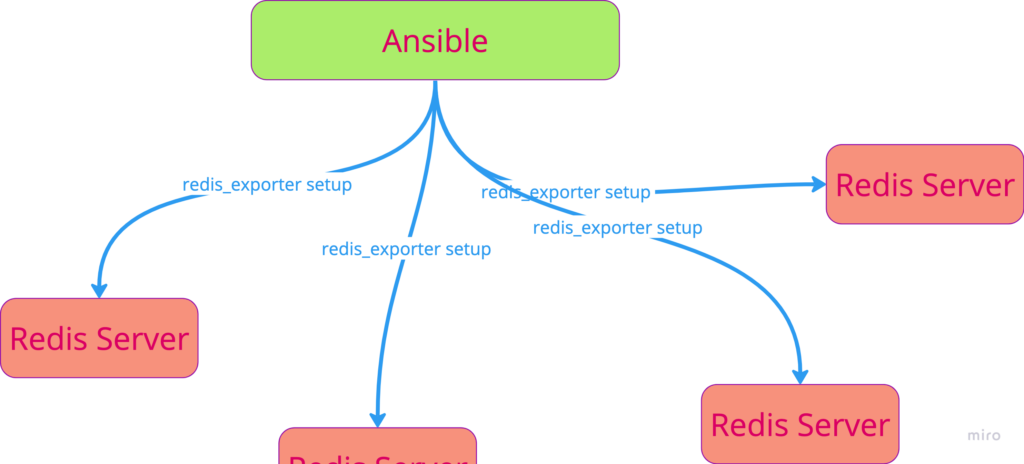Introduction
Simplify redis exporter setup through Ansible using role. Redis exporter exports redis metrics for Prometheus.
Generally, we install redis_exporter on the redis server. Prometheus service periodically pulls redis metrics through redis_exporter. Ansible facilitates and automates redis_exporter setup at scale.
Please Review this post to learn about redis_exporter setup with ansible using role.

Prerequisite:
- Learn about redis_exporter
- Learn about redis
- Learn about ansible
- Learn about roles
- setup redis-server
Redis exporter is an agent installed on the redis server through which Prometheus scrapes metrics for redis.
Major steps in the redis exporter setup through Ansible using Role are below
- Create redis-exporter role
- Download redis_exporter
- Extract the redis_exporter binary and move to /usr/bin or /usr/local/bin
- Create redis_exporter user
- Customise redis_exporter service conf
- Restart redis_exporter service
Let us understand the above sub-tasks in more detail.
Create redis_exporter role
cd ansible
# creates roles dir if if does not exists as below
mkdir roles
cd roles
ansible-galaxy role init redis_exporter
Download redis_exporter
Note: version is variable in above task, please add version in defaults/main.yml as below version: 1.55.0
Add the below task in redis_exporter/tasks/main.yml
- name: Download redis exporter
command: wget https://github.com/oliver006/redis_exporter/releases/download/v{{version}}/redis_exporter-v{{version}}.linux-amd64.tar.gz
Extract the redis_exporter binary and move to /usr/local/bin
# Extract the archive
- name: Extract redis exporter archieve
command: tar xvfz redis_exporter-v{{version}}.linux-amd64.tar.gz
# Move binary to /usr/local/bin (Make sure /usr/local/bin path is added into PATH)
- name: Move redis-exporter to /usr/bin
command: mv redis_exporter-v{{version}}.linux-amd64/redis_exporter /usr/local/bin
# Delete archive and extracted directory
- name: Delete redis_exporter-v{{version}}.linux-amd64.tar.gz
file:
name: redis_exporter-v{{version}}.linux-amd64.tar.gz
state: absent
- name: Delete redis_exporter-v{{version}}.linux-amd64 directory
file:
name: redis_exporter-v{{version}}.linux-amd64
state: absent
Create redis_exporter user
- name: Create redis_exporter user
user:
name: redis_exporter
system: yes
create_home: no
shell: /bin/false
Customise redis_exporter service conf
Create redis_exporter service template
touch templates/redis_exporter.service.j2
Add below conf in templates/redis_exporter.service.j2
######################################
[Unit]
Description=Redis Exporter
Wants=network-online.target
After=network-online.target
[Service]
Type=simple
User=redis_exporter
ExecStart=/usr/bin/redis_exporter \
-web.listen-address ":9121" \
-redis.addr "redis://127.0.0.1:{{redis_port}}"
[Install]
WantedBy=multi-user.target
######################################
Note: Add redis_port value in defaults/main.yml as 6379
Also, if redis is password protected then change ExecStart as below and add password value defaults/main.yml
ExecStart=/usr/bin/redis_exporter \
-web.listen-address ":9121" \
-redis.addr "redis://127.0.0.1:{{redis_port}}" \
-redis.password "{{password}}"
Add below task in tasks/main.yml
- name: Copy redis_exporter.service file to /etc/systemd/system
template:
src: redis_exporter.service.j2
dest: /etc/systemd/system/redis_exporter.service
notify: - Restart redis_exporter
Restart redis_exporter service
Add below handler in handlers/main.yml
- name: Restart redis_exporter
systemd:
name: redis_exporter
state: restarted
enabled: yes
daemon_reload: yes
Finally, tasks/main.yml will be as below
---
# tasks file for redis_exporter
- name: Extract redis exporter archieve
command: tar xvfz redis_exporter-v{{version}}.linux-amd64.tar.gz
- name: Move redis-exporter to /usr/bin
command: mv redis_exporter-v{{version}}.linux-amd64/redis_exporter /usr/bin/
- name: Delete redis_exporter-v{{version}}.linux-amd64.tar.gz
file:
name: redis_exporter-v{{version}}.linux-amd64.tar.gz
state: absent
- name: Delete redis_exporter-v{{version}}.linux-amd64 directory
file:
name: redis_exporter-v{{version}}.linux-amd64
state: absent
- name: Create redis_exporter user
user:
name: redis_exporter
system: yes
create_home: no
shell: /bin/false
- name: Restart redis_exporter
systemd:
name: redis_exporter
state: restarted
enabled: yes
daemon_reload: yes
the final version of defaults/main.yml
---
# defaults file for redis_exporter
version: 1.55.0
redis_port: 6379
password: myredispass
Inventory setup
Create inventory/prod/redis_servers.yml
Add below contents
all:
children:
redis_servers:
hosts:
redis_server_01:
private_ip: 10.15.0.2
redis_server_02:
private_ip: 10.15.0.3
Master playbook setup
Create the redis_servers.yml file in the playbooks folder and add the below content.
# redis_servers.yml
- name: Redis server setup
hosts: redis_servers
become: yes
roles:
- ../roles/redis_exporter
Run the playbook
cd playbooks
ansible-playbook redis_servers.yml -i inventory/prod/redis_servers.yml
Upon successful execution of the above command, you can check redis metrics in Prometheus or Grafana.
Conclusion
In this post, we learned about the redis exporter setup with Ansible.
In conclusion, the streamlined deployment of the Redis Exporter setup with Ansible, distilled into a straightforward three-step process, exemplifies the elegance of automation. This approach emphasizes the potency of Ansible’s role-based orchestration and underscores its user-friendly design.
By simplifying the deployment journey, users can seamlessly integrate Redis Exporter into their systems efficiently and easily, allowing them to focus more on broader aspects of system management. This method encapsulates the core philosophy of Ansible—delivering powerful automation that is both accessible and precise, ensuring that users can effortlessly enhance their systems with the advanced capabilities of Redis Exporter.
In essence, this streamlined deployment method is a testament to Ansible’s commitment to user-centric automation, where complexity is abstracted, and efficiency is prioritized, facilitating a more intuitive and productive system management experience for all.
Please enjoy the post!!
1 thought on “Redis Exporter Setup through Ansible Using Role in 6 Easy Steps”